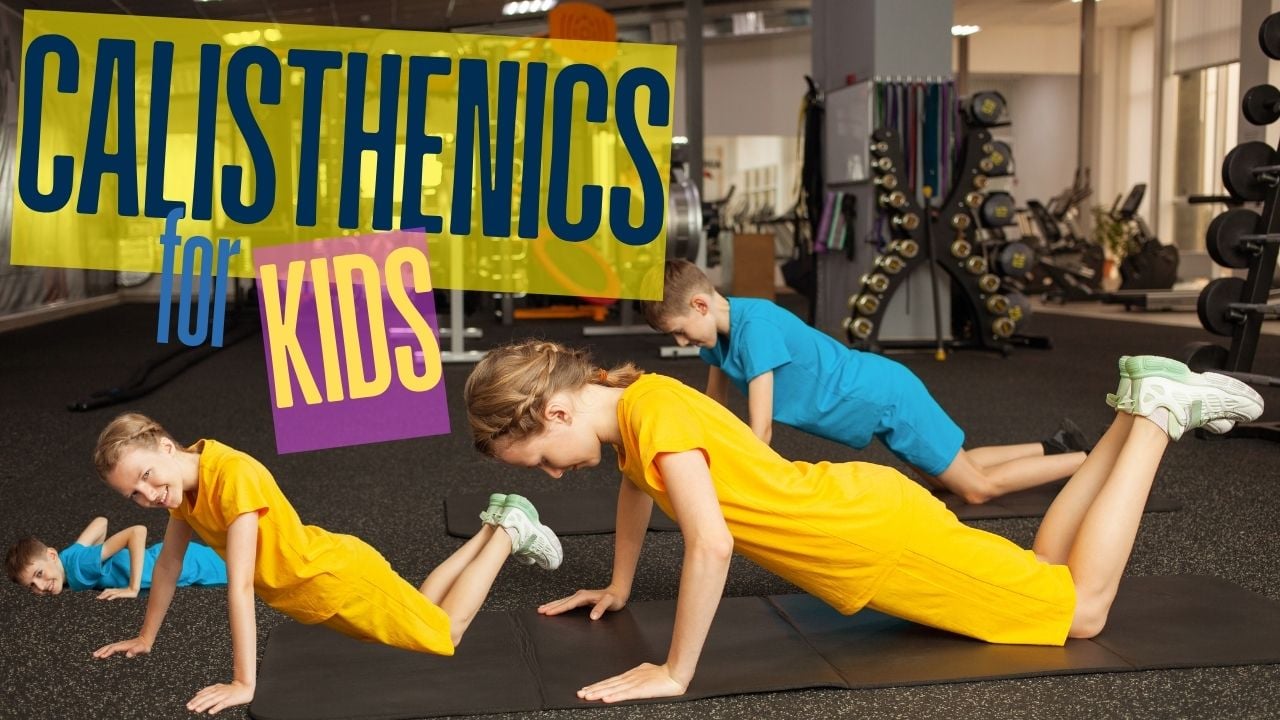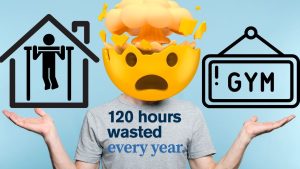I started calisthenics at six years old without even knowing it. Technically, I was doing karate—but like many traditional martial arts, it came with a heavy dose of bodyweight functional training. We did push-ups on our fists, squatted until our legs shook, held planks until we collapsed, did hanging leg raises on stall bars, sit-ups, partner drills, and even played around on gymnastics rings. Nobody called it “strength training” back then. It was just what we did to build discipline, control, and physical confidence.
Fast forward a few decades and I’m still training, stronger than ever, injury-free.
Now that I coach adults and kids, and run a calisthenics website that reaches thousands of families, I often hear the same questions from parents:
“Is it safe for my kid to do push-ups?”
“Could a pull-up harm their joints?”
“Is it too early to start bodyweight training?”
These are good questions. But I think we’re asking the wrong things.
Instead of worrying about whether movement will hurt your child (it won’t—if done right), we should be asking how to help our kids fall in love with it. Because movement, strength, coordination, and confidence are all things they shouldn’t have to relearn as adults. But too many do.
Let me walk you through what I’ve learned from a lifetime of training, coaching, and paying attention to the research—and share some things that most guides overlook.
Busting the Biggest Myths about Calisthenics for Kids
As a coach who works with kids and trains every week in public parks, I’ve heard a lot of concerns from parents—some valid, some based on old-school fears. Let’s clear the air and walk through some of the most common (and uncommon) myths about kids and calisthenics.
❌ Myth 1: “Strength training stunts growth.”
Truth: This is the most common myth—and completely false.
There’s no evidence that bodyweight or resistance training interferes with a child’s growth or damages growth plates when done properly. In fact, multiple studies (including research published in Pediatrics and by the NSCA) show that supervised strength training can improve bone mineral density, support healthy joint development, and even increase growth hormone levels naturally.
What does cause injury? Poor supervision, bad technique, and doing too much too soon—just like in any sport.
❌ Myth 2: “Pull-ups and handstands are dangerous for young joints.”
Truth: Not if they’re introduced gradually and taught with proper progressions.
When I coach kids, I don’t start with full handstands or strict pull-ups. We build up through wall-supported holds, hangs, and rows. These movements, when done with control and intention, actually improve joint stability, tendon strength, and proprioception (body awareness).
The danger isn’t in the exercise—it’s in rushing progressions or letting kids train unsupervised without understanding form.
❌ Myth 3: “Bodyweight training is too hard for kids.”
Truth: Only if you forget that everything is scalable.
No coach expects a 7-year-old to crank out dips and muscle-ups. But incline push-ups, crawling, bear walks, active hangs, and squat variations? All of those are bodyweight movements, and all of them are perfectly appropriate—even fun—for young kids.
Kids naturally gravitate toward movement when it’s playful and not framed as a chore. Give them the right level of challenge, and they’ll surprise you.
❌ Myth 4: “They’ll get injured doing calisthenics.”
Truth: Actually, calisthenics has a lower injury rate than most organized sports.
Data from Sports Health and multiple pediatric studies show that youth resistance training—when supervised—is far safer than soccer, basketball, or gymnastics. Most injuries in training come from lack of supervision, poor form, or repetitive overload.
The beauty of calisthenics is that it teaches movement quality, not just movement quantity. That’s exactly what reduces injury risk long-term.
❌ Myth 5: “They already play sports—why add more?”
Truth: Calisthenics builds the foundation that helps them perform better in sports.
If your child plays football, swims, does dance, or climbs—it doesn’t matter. Calisthenics builds core control, joint strength, body awareness, and mobility that transfers into almost every sport. Think of it as cross-training that doesn’t require equipment or a gym membership.
I’ve seen kids run faster, jump higher, and stay injury-free simply because they could plank well or control their scapula on a pull-up bar.
❌ Myth 6: “My child isn’t athletic—this isn’t for them.”
Truth: Calisthenics isn’t just for “athletic” kids—it’s how you become athletic.
There’s a huge misconception that you need to be naturally sporty to benefit from bodyweight training. I’ve coached plenty of quiet, shy, or uncoordinated kids who didn’t fit into team sports—and calisthenics gave them a way to build strength at their own pace. No games. No pressure. Just personal progress.
It’s one of the most inclusive and accessible ways to help any child build confidence through movement.
❌ Myth 7: “Strength training will make my kid bulky.”
Truth: Not even close.
Kids don’t have the hormonal profile to build big, bulky muscles—especially with calisthenics, which emphasizes relative strength, endurance, and control over hypertrophy. What they do build is a strong, functional body that can move well and feel good doing it.
And honestly, strength isn’t about looks. It’s about capability. Focus on what their body can do, not what it looks like.
❌ Myth 8: “It’s too serious—they should just play.”
Truth: Calisthenics is play—if you introduce it the right way.
Climbing, crawling, balancing, jumping, hanging—these are all calisthenics movements. It’s how kids naturally train on playgrounds without knowing it. You don’t need to turn it into a strict program. You can keep it light, creative, and playful while still building strength and coordination.
Structure and freedom don’t have to be opposites. They can exist together—and that’s where kids thrive.
If you’ve had any of these concerns, you’re not alone. I hear them all the time. But I’ve also seen what happens when we let kids explore their physical potential with the right support.
They don’t get hurt—they get stronger. They don’t get bored—they get creative. And they don’t get left behind—they learn to lead.
That’s what calisthenics can offer—not just a stronger body, but a stronger sense of self.
What Age Can Kids Start Calisthenics?
There’s no magic number, but if a child can run, jump, and climb, they can start learning the basics of calisthenics.
The American Academy of Pediatrics (AAP) and the National Strength and Conditioning Association (NSCA) both agree that resistance training—including bodyweight training—is safe for kids, even from as young as 5–7 years old, provided the movements are age-appropriate, supervised, and focus on technique over load.
👉 In plain terms: Yes, your 6-year-old can do push-ups, squats, and pull-ups—as long as they’re having fun, not forcing reps, and not being pushed into dangerous challenges.
What Exercises Are Safe for Kids by Age?
Here’s how I generally break it down:
Ages 4–7:
- 🟢 Animal walks (bear, crab, lizard)
- 🟢 Hanging from bars
- 🟢 Bodyweight squats
- 🟢 Wall push-ups
- 🟢 Jumping and crawling drills
Focus is on coordination, play, and learning how to move.
Ages 8–11:
- 🟢 Incline and regular push-ups
- 🟢 Inverted rows
- 🟢 Assisted pull-ups (bands or chair)
- 🟢 Lunges, squats, jumps
- 🟢 Basic core exercises (planks, dead bugs)
This is the perfect window to build a foundation—kids respond really well here.
Ages 12+:
- 🟢 Full push-ups, dips, pull-ups
- 🟢 Basic ring exercises
- 🟢 Handstand progressions
- 🟢 Explosive work like jump squats, sprints
Now they can start training similarly to adults—but still with a focus on form, not ego.
Build a Foundation, Not Just Skills
Too many kids today specialize too early—joining a single sport year-round without time to explore movement generally. This leads to overuse injuries, burnout, and missed opportunities to develop as well-rounded athletes.
Calisthenics is the perfect antidote. It builds general strength, coordination, mobility, balance, and body awareness. These are tools that apply across every sport—and in everyday life.
Rather than asking, “What’s the best sport for my child?” ask, “How can I give my child the broadest movement foundation possible?”
Strength Builds Confidence
This is the part that often gets overlooked. Strength isn’t just about the body—it’s about identity.
When a child masters a new movement—holds their first plank, completes a push-up, or conquers the monkey bars—they feel powerful. It builds self-trust. Especially during preteen years, when body image and self-esteem can start to take a hit, calisthenics gives them something solid to hold onto: “I can do this.”
That kind of intrinsic confidence carries over into everything—school, friendships, and future sports.
Supporting Mental Health Through Movement
We talk a lot about the physical benefits of calisthenics—strength, mobility, coordination—but we often overlook the mental side. And that’s a mistake, because kids today are facing a mental health crisis that movement can help address in very real ways.
Rates of anxiety, depression, and attention issues among children and teens have risen significantly in recent years. A combination of academic pressure, social media, reduced physical activity, and disconnection from nature and play are key contributors. Many kids today spend more time sitting, scrolling, and comparing themselves than moving, playing, or being present in their own bodies.
That’s where calisthenics—and sports in general—can make a powerful difference.
When a child learns how to hold a handstand or work toward their first push-up, they’re doing more than building muscle. They’re learning goal-setting. They’re proving to themselves that with practice, effort leads to progress. That process builds self-efficacy—the belief that “I can do hard things”—which is directly linked to better mental health and lower anxiety.
Regular physical activity also:
- Improves sleep quality and energy regulation
- Reduces stress and emotional volatility
- Boosts mood through endorphin release
- Improves focus and classroom performance
- Provides a healthy outlet for frustration or restlessness
And let’s not forget the social benefits. Joining a martial arts class, parkour crew, or gymnastics team gives kids:
- A sense of belonging outside the classroom
- New friendships based on shared effort and play
- A purpose beyond screens or school grades
- Positive role models and mentors
Calisthenics, especially in group settings or guided by a trusted adult, can become a mental anchor for kids. It’s a space where they feel safe, challenged, and seen—not judged for how they look or how they perform in school, but celebrated for how they move and improve.
In a world that often encourages kids to be passive consumers of content, movement reminds them they’re active participants in their own lives. That’s not just fitness—that’s freedom.
Are There Any Risks?
Like any sport, calisthenics carries a risk of injury—but the risk is very low when the training is appropriate and coached properly.
The NSCA states that the injury rate in youth resistance training is actually lower than in most organized sports like soccer or basketball. Most injuries come from accidents (e.g., falling off bars) or from poor form with high volume or load. That’s why supervision matters.
In my experience, the most common issues I’ve seen are:
- Wrist discomfort from handstands on hard surfaces (easy fix: soft mats or parallettes)
- Elbow irritation from too many pull-ups too soon (fix: mix in rows and rest days)
- Overuse from lack of variety or poor programming (fix: make it fun, mix it up)
My Advice to Parents
As both a coach and someone who grew up doing this stuff, here’s what I recommend:
- ✅ Focus on fun and movement first. If they enjoy it, they’ll stick with it.
- ✅ Prioritize technique over reps or “show-off” moves.
- ✅ Avoid overcoaching. Kids don’t need to train like adults.
- ✅ Include variety: jumping, crawling, climbing, balancing.
- ✅ Make rest and recovery part of the process.
- ✅ Encourage—but don’t pressure.
Let kids explore what their bodies can do. Calisthenics is one of the most natural and low-risk ways for kids to build strength, body control, and confidence. No machines, no heavy weights—just their body and gravity.
Create Opportunities for Exploration
Even with a movement-rich home and engaged parents, the best way for kids to develop physical literacy is through exposure to diverse movement styles. I always tell parents: don’t think of calisthenics as a strict program to follow—think of it as a foundation to build from.
Here are some excellent ways to get your child moving and excited about exercise:
Martial Arts
Karate, judo, taekwondo, and Brazilian jiu-jitsu are fantastic starting points. When I began karate, every class included squats, push-ups, planks, leg raises, and hangs from stall bars. These disciplines also teach focus, discipline, and emotional regulation.
Gymnastics and Parkour
For kids who love climbing and jumping, gymnastics and parkour classes are a perfect match. Gymnastics builds strength-to-weight ratio, balance, and control. Parkour teaches fluid movement, coordination, and safety while exploring creative physical challenges.
Holiday Camps and Movement Clubs
Summer camps and movement clubs during school breaks are a great way to expose kids to a variety of styles—obstacle courses, calisthenics games, crawling, climbing, and agility drills. Many kids discover their love for movement at these short-term programs.
You can find gymnastics-focused camps in the USA or browse among many different camp offerings on GoFunlo (a marketplace for summer camps and school trips, currently mainly available in Europe).
Dance and Movement Arts
Dance styles like breakdancing, hip-hop, and capoeira are rich in isometric strength and coordination. These disciplines offer structure through music and movement, often resonating with kids who may not be drawn to traditional sports.
Let kids try multiple disciplines. One term of gymnastics, a few months of martial arts, a parkour workshop—they’ll learn transferable skills and get to figure out what they truly enjoy.
Make Your Home Movement-Friendly
You don’t need a gym or special program. What matters is that your home invites movement. Set up a few simple tools:
- A pull-up bar in a doorway
- Gymnastics rings in the garage, balcony, or yard
- A soft mat for handstands or rolling
- Chalk or stickers to track daily movement challenges
Instead of strict rules, provide gentle nudges. Leave the rings hanging. Suggest a 30-second squat hold before dinner. Keep it casual—but consistent.
Train Together as a Family
One of the most powerful things you can do is to lead by example. If your child sees you moving, playing, and challenging yourself, they’ll learn that physical activity is a normal, lifelong habit—not just something for kids.
Try:
- Family push-up or plank challenges
- Walks with movement breaks (jumps, squats, hangs)
- Partner games like mirror squats, animal walks, or wheelbarrow races
The goal isn’t to be perfect—it’s to show up together.
Conclusion: Raising Capable, Confident Movers
If you’re a parent wondering whether calisthenics—or any form of bodyweight strength training—is right for your child, the answer is a resounding yes. When approached with care, curiosity, and play, it’s one of the safest, most effective ways to help kids build not just stronger bodies, but more confident and resilient minds.
Movement is how children explore the world. It’s how they learn their limits—and then learn to expand them. In a time when too many kids are disconnected from their own bodies, overwhelmed by pressure, or stuck in sedentary routines, calisthenics offers a simple and powerful reset.
It doesn’t require expensive gear, elite coaching, or apps. It just takes a bit of space, a few challenges, and your encouragement.
Start small. Stay playful. Focus on effort, not perfection. And remember: every time your child climbs, jumps, balances, or holds themselves up—physically or emotionally—they’re doing the real work of growing up strong.
You don’t need to raise an athlete. Just raise a human who trusts their body, enjoys movement, and knows they’re capable.
That’s a lifelong gift.
Scientific Findings and Resources
📚 1. NSCA Position Statement: Youth Resistance Training
Source: Faigenbaum et al., Journal of Strength and Conditioning Research, 2009
Link: https://doi.org/10.1519/JSC.0b013e31819c2f8a
Key points:
- Supervised resistance training, including bodyweight exercises, is safe and effective for youth.
- It enhances muscle strength, power, bone density, motor skills, and injury resistance.
- Common fears like growth plate damage or stunted growth are not supported by scientific evidence.
“There is no evidence-based research that resistance training has a negative impact on growth in children or adolescents.”
📚 2. American Academy of Pediatrics (AAP) Clinical Report on Strength Training in Children
Source: Stricker et al., Pediatrics, 2020
Link: https://doi.org/10.1542/peds.2020-0997
Key points:
- Endorses strength training starting as young as 7–8 years, or even earlier if the child can follow instructions.
- Highlights low injury risk when properly supervised.
- Encourages bodyweight training like push-ups and pull-ups as foundational and safe.
“Concerns that strength training might stunt a child’s growth or damage growth plates are not supported by research.”
📚 3. Resistance Training for Children and Adolescents: Benefits, Risks, and Guidelines
Source: Lloyd et al., British Journal of Sports Medicine, 2014
Link: https://bjsm.bmj.com/content/48/7/498
Key points:
- Resistance training helps reduce injury risk in other sports (e.g. football, gymnastics).
- Well-structured programs increase self-esteem, body composition, and athleticism.
- Children can perform bodyweight training safely and effectively, with appropriate volume and technique.
📚 4. Systematic Review: Resistance Training in Youth
Source: Behringer et al., Pediatrics, 2010
Link: https://doi.org/10.1542/peds.2010-0445
Key points:
- Reviewed 42 studies and found significant strength gains in both children and adolescents.
- No evidence of injury to the growth plates or musculoskeletal system when done properly.
“Youth resistance training, including bodyweight exercise, is safe and promotes overall musculoskeletal health.”
📚 5. Effect of Strength Training on Bone Growth in Children
Source: MacKelvie et al., Journal of Bone and Mineral Research, 2002
Link: https://doi.org/10.1359/jbmr.2002.17.2.197
Key points:
- Strength training can increase bone mineral density, which helps prevent injuries and supports long-term skeletal development.
- Resistance or impact training during youth is critical for peak bone mass acquisition.




